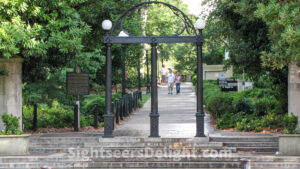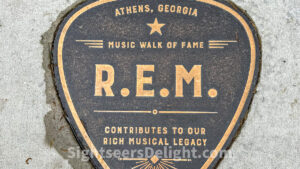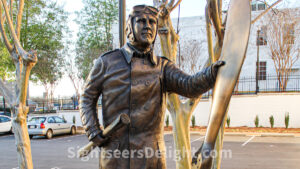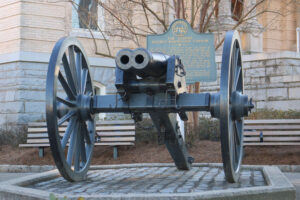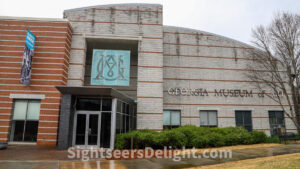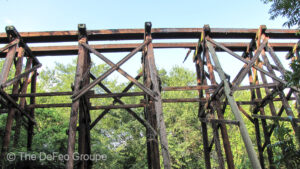The Arch was constructed in the 1850s as part of a larger iron fence protecting the university campus. It is generally regarded as the entrance to both the University of Georgia and the city of Athens. The Arch comprises three pillars representing Georgia’s state motto: “Wisdom, Justice, and Moderation.”
30602
The Athens Music Walk of Fame, unveiled in 2020 in downtown Athens, highlights the artists, organizations and locations that helped make the Classic City’s music scene legendary. The Walk of Fame is located downtown near some of Athens’ most famous music venues, including the Georgia Theatre and the 40 Watt Club. In 2020, the Athens Music Walk of Fame inducted ten people in downtown Athens, and the Athens Music Walk of Fame Committee selects five inductees each year. The Athens Music Walk of Fame Committee, appointed by the mayor, considers artists’ contributions, historical significance, career span, musical style, and diversity representation. Local designer Allen Sutton designed the plaque. The walk is funded by the Athens Cultural Affairs Commission and supported by the Athens Downtown Development Authority, Athens-Clarke County Leisure Services Arts Division, and Athens-Clarke County Transportation and Public Works Streets & Drainage Division.
30601
Located inside Memorial Park in the Five Points neighborhood, Bear Hollow is a zoo and natural habitat for rescued animals that cannot be released into the wild. Some are physically disabled, while others cannot care for themselves in the wild or are too trusting and fond of people.
30606
The Wright Brothers may have all the glory in aviation history. But, when it comes to retelling the story of flight, at least in Georgia, Ben Epps is right there with the brothers from Dayton, Ohio. Four years after the Wright Brothers made history, Epps in 1907 piloted a plane he built. While details of that first flight are few, Epps cemented himself in flying history. In 2011, the Athens community unveiled a statue on Washington Street, across from Epps’ former shop.
In November 2008, Athens dedicated “The Character of a Champion,” a 14-foot-tall bronze statue of Vince Dooley, the legendary former football coach of the Georgia Bulldogs. Athens sculptor Stan Mullins crafted the statue of Dooley, depicting the former coach being hoisted onto the shoulders of his players after winning the 1980 national championship. Dooley was head coach from 1964 until 1988. He was the university’s athletic director from 1979 to 2004 and was inducted into the College Football Hall of Fame in 1994. The memorial was dedicated in 2008 before the annual Georgia-Georgia Tech football game.
30605
The Double-Barreled Cannon was the brainchild of Dr. John Gilleland, a dentist from Jackson County, Ga., and a member of Mitchell’s Thunderbolts. Built in 1862 at the Athens Foundry and Machine Works, the Double-Barreled Cannon is today little more than a bookmark in history and a rather unique relic. The cannon was designed to fire two cannonballs connected by a chain so as to “mow down the enemy somewhat as a scythe cuts wheat.” According one account, the cannon was tested on a site along Newton Bridge Road, but since the two barrels did not have the same range, the chain broke in mid-air. According to some sources, one of the cannon balls killed a cow in a field nearby. According to a number of sources, including books and newspaper accounts, the cannon was not used in battle. But, according to a Confederate Veteran article, the cannon was used during a skirmish, but not as originally designed.
The Georgia Museum of Art is located on the University of Georgia campus in Athens and has been the official art museum of the state of Georgia since 1982. It started in 1948 in the basement of the old library on the university’s North Campus. In April 1996, the museum opened a new building in the Performing and Visual Arts Complex on the university’s East Campus. The museum has over 18,000 objects in its permanent collection, an increase from the core of 100 paintings museum founder Alfred Heber Holbrook donated. Its permanent collection includes American paintings from the 19th and 20th centuries, American, European, and Asian works on paper, southern decorative arts, and Asian art.
30602
The “Murmur Trestle” has for years attracted R.E.M. fans from around the globe. Gracing the back of the band’s 1983 album “Murmur,” the bridge is best known today as the Murmur Trestle. The trestle was built in 1883 and served the Georgia Railroad and later CSX Transportation and was last used in 1998. Athens-Clarke County purchased the trestle in 2000.
30601
The State Botanical Garden of Georgia is a 313-acre botanical garden operated by the University of Georgia. The university established the garden in 1968 to study and appreciate plants and nature. This garden is a “living laboratory” for teaching, research, public service, and outreach missions for the university and Georgia residents. The garden features a conservatory, roughly five miles of nature trails and a diverse range of natural features and includes various plant communities and habitats that are common in the Georgia Piedmont region. In 1984, it was officially recognized as Georgia’s State Botanical Garden.
30605

